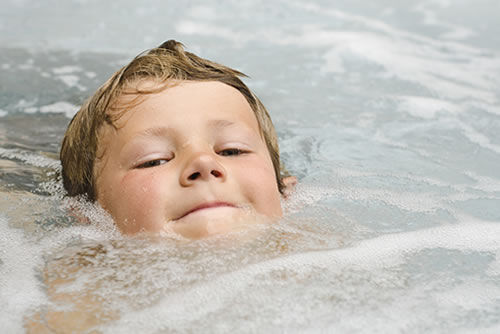Hot tub wiring is a crucial task for anyone looking to install a new spa at home. It requires careful planning and attention to safety. Proper hot tub wiring ensures your spa runs smoothly and safely for years to come.
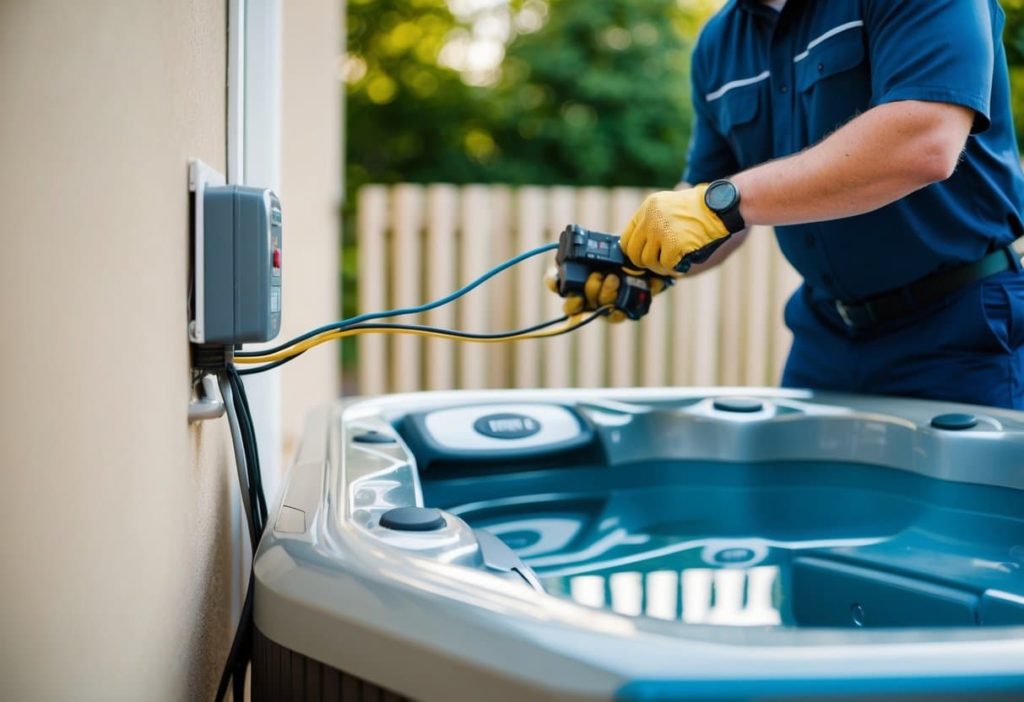
Many homeowners wonder if they can wire a hot tub themselves. While it’s possible for those with electrical experience, most people should hire a licensed electrician. Hot tubs need a dedicated circuit and special wiring to handle their power demands.
The wiring process involves running the right gauge wire from your home’s electrical panel to the spa. It also includes installing a disconnect switch near the hot tub for safety. Getting the wiring right is key to enjoying your new hot tub without worries.
Hot Tub Wiring Basics
Hot tub wiring is a crucial aspect of installing these relaxing backyard fixtures. It’s important to get it right for safety and proper function.
Most hot tubs need a dedicated 240-volt circuit. This high voltage powers the heater and pumps effectively. The circuit should be separate from other household electrical systems.
A thick cable carries electricity from the main panel to the hot tub. The size of this cable depends on the tub’s power needs and distance from the panel.
Water and electricity don’t mix well. That’s why hot tub wiring must be watertight and follow strict codes. Special waterproof connectors and conduits protect the wires.
A ground fault circuit interrupter (GFCI) is a must. It cuts power quickly if it detects a problem, keeping people safe from shocks.
The disconnect box is another key part. It lets you turn off power to the hot tub for maintenance or emergencies. It should be easy to reach but not too close to the water.
Proper grounding is essential. It helps prevent electric shocks by giving excess current a safe path to the ground.
Hot tub wiring isn’t a DIY job. It needs a licensed electrician to ensure it meets all safety standards and local codes.
Safety Regulations and the National Electrical Code
Proper wiring for hot tubs is crucial for safety and legal compliance. The National Electrical Code (NEC) sets key standards that guide electricians and homeowners in safe installation practices.
Importance of Complying with the NEC
The NEC is the benchmark for electrical safety in North America. It outlines rules for hot tub wiring to prevent shocks, fires, and other hazards. Following the NEC is not just a good idea – it’s often the law.
Permits and inspections are typically needed for hot tub installations. These checks make sure the work meets code requirements. A licensed electrician should handle the job to ensure it’s done right.
The NEC requires GFCI protection for hot tubs. This device cuts power if it detects a ground fault, reducing shock risks. Proper grounding is also essential for safety.
Identifying the Key Elements of Code Compliance
The NEC has specific rules for hot tub wiring:
- Wire size and type
- Disconnect location
- Bonding and grounding methods
- GFCI protection
A key part of code compliance is using the right materials. This includes waterproof conduits and outdoor-rated cables.
The disconnect switch must be visible from the hot tub and at least 1.5 metres away. This allows quick power cut-off in an emergency.
Bonding joins metal parts to create an equipotential plane. This prevents voltage differences that could cause shocks.
Proper grounding connects the system to the earth, providing a safe path for fault currents. This is critical for electrical safety in wet areas.
Choosing the Right Materials and Tools
Proper materials and tools are crucial for safe hot tub wiring. Quality components ensure a reliable electrical system that meets code requirements and functions well for years to come.
Selecting Quality Wires and Cables
Copper wire is the top choice for hot tub wiring. It’s durable and conducts electricity well. The wire gauge matters too. Thicker wire handles more current. Check local codes for the right size.
Insulation is key. Look for wire-rated for wet locations. THWN or XHHW insulation works well. Avoid aluminum wire. It’s not as reliable as copper for this job.
Buy wire from trusted suppliers. Cheap wire may not meet standards. It could overheat or fail, causing safety issues.
Finding Suitable Conduits and Connectors
PVC conduit is common for hot tub wiring. It’s waterproof and easy to work with. Metal conduit is an option too, but it costs more.
Choose the right conduit size. It should fit the wires without cramming. Allow some space for future upgrades.
Connectors join conduit pieces. Waterproof connectors are a must. They keep moisture out of the system.
For tools, you’ll need:
- Screwdrivers
- Wire strippers
- PVC cutter or hacksaw
- Measuring tape
- Level
Quality tools make the job easier and safer. Don’t skimp on tool quality. Good tools last longer and work better.
Planning Your Hot Tub’s Electrical Supply
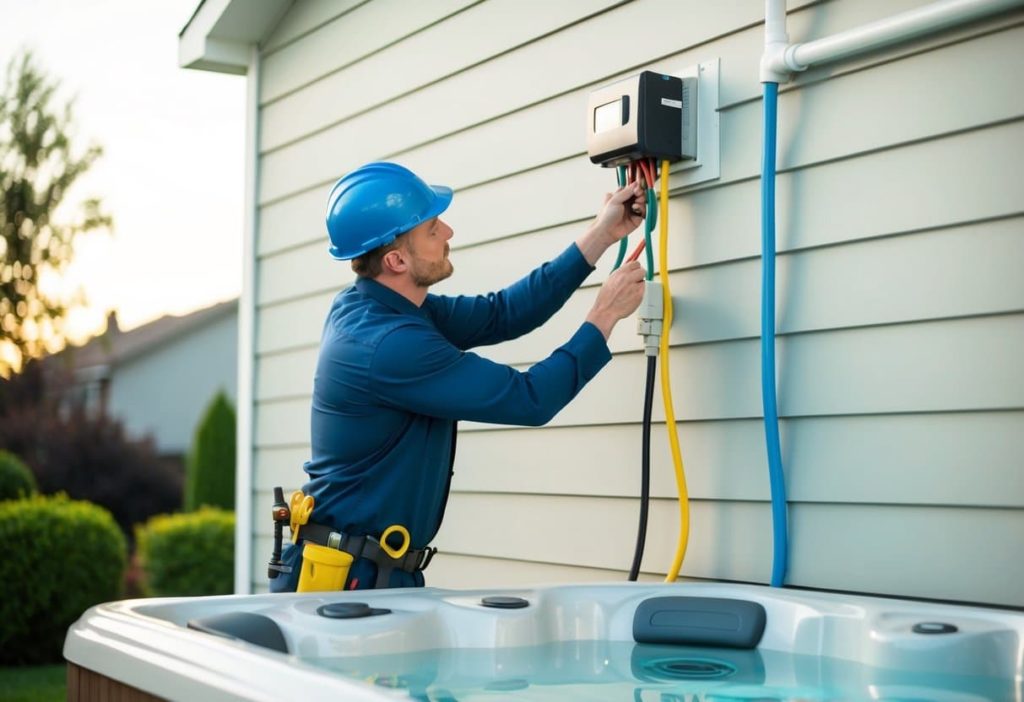
Setting up your hot tub’s power supply needs careful thought. It’s important to know how much power you need, where to put the tub, and how to run the wires safely.
Determining Power Requirements
Most hot tubs need 220-240 volts of power. Check your tub’s manual for exact specs. Look at the amp rating too. It’s often 50 or 60 amps.
You might need to upgrade your home’s electrical panel. An electrician can tell you if you have enough power. They’ll also make sure your system can handle the extra load.
Don’t forget about other backyard gadgets. Count up all the power they use. This helps avoid overloading your circuits.
Deciding on the Placement of the Hot Tub
Pick a spot that’s both comfy and close to power. The closer to your house, the less wire you’ll need. This can save money.
Think about privacy and views. You want to enjoy your soak without nosy neighbours.
Check local rules about how far the tub must be from property lines. Also, look for overhead power lines. Keep the tub far from those for safety.
Make sure the ground is level and can support the weight. A full hot tub is very heavy.
Mapping the Route for Wires and Conduits
Plan the path from your power source to the hot tub. It should be as short and straight as possible.
You’ll need to dig a trench for the wires. It must be deep enough to meet local codes. Usually, this is about 18 inches.
Use conduits to protect the wires. PVC pipes work well for this. They shield the wires from water and damage.
Avoid tree roots when digging. They can damage wires over time. Also, stay clear of other buried utilities like gas lines.
Plan for a disconnect box near the tub. This lets you cut power quickly if needed. It’s a key safety feature.
Installing Required Breakers and Disconnects
Proper electrical protection is crucial for safe hot tub operation. The right breakers and disconnects help prevent shocks and fires.
Integrating GFCI Breaker into the Service Panel
A GFCI breaker is essential for hot tub safety. It shuts off power if it detects a ground fault. Install the GFCI breaker in the main service panel. Choose a breaker that matches the hot tub’s amperage needs.
Turn off the main power before installation. Remove the panel cover carefully. Attach the GFCI breaker to an empty slot. Connect the hot wire to the breaker’s “LINE” terminal. The neutral wire goes to the “LOAD” terminal.
Test the GFCI after installation. Press the “TEST” button – it should trip. If it doesn’t, check the wiring and try again.
Setting Up a Proper Disconnect Device
A disconnect device lets you cut power to the hot tub quickly. Install it within sight of the hot tub, but at least 1.5 metres away. This placement allows for easy access in emergencies.
Choose a disconnect that matches your hot tub’s voltage and amperage. Weatherproof boxes work best for outdoor installs. Mount the box securely to a wall or post.
Wire the disconnect between the GFCI breaker and the hot tub. Connect the incoming power to the “LINE” side. The wires to the hot tub go on the “LOAD” side.
Label the disconnect clearly. This helps others find it in urgent situations. Test the disconnect to ensure it cuts power as intended.
Making Connections: Wiring and Grounding
Proper wiring and grounding are key to a safe hot tub setup. These steps ensure the tub works right and keeps users safe from electric shocks.
Connecting to the Main Electric Panel
To wire a hot tub, start at the main electric panel. Pick a free slot for a new breaker. The breaker size depends on the hot tub’s power needs. A 50-amp breaker is common for many tubs. Use thick wires that can handle the load. Run these wires from the panel to where the hot tub will go.
Make sure to use wires rated for outdoor use. They should be in a conduit to protect them. The conduit can be PVC or metal. Bury it at least 18 inches deep if it runs underground.
Leave enough extra wire at both ends. This makes it easier to connect things later. Always turn off the main power before working in the panel.
Executing Grounding and Bonding Procedures
Grounding and bonding keep people safe from electric shocks. Connect a ground wire from the panel to the hot tub’s ground point. This wire gives a safe path for stray currents.
Bond all metal parts of the hot tub. This means connecting them with a wire. Include pumps, heaters, and the tub shell if it’s metal. Use a thick copper wire for this job. It should be at least #8 gauge.
Connect this bond wire to the main ground wire. This makes sure all parts are at the same electric potential. It stops dangerous voltage differences.
Fulfilling Neutral and Ground Wire Requirements
Hot tubs need both neutral and ground wires. The neutral wire carries the current back to the panel. The ground wire is a safety feature.
Use a white wire for neutral. It should be the same size as the hot wires. The ground wire can be green or bare copper. It’s often one size smaller than the hot wires.
In the tub’s electrical box, connect these wires to the right spots. The neutral goes to the neutral bar. The ground wire attaches to the ground bar. Keep these wires separate in the box. Don’t mix them up or connect them.
Check all connections twice. Loose wires can cause big problems. Use the right size wire nuts for each connection. Wrap them with electrical tape for extra safety.
Special Considerations for Plug-and-Play Hot Tubs

Plug-and-play hot tubs offer convenience but require careful attention to electrical needs. These portable units have specific power requirements that differ from standard hot tubs.
Electrical Needs for Portable Hot Tubs
Plug-and-play hot tubs typically run on 120 V power, which is the standard household outlet voltage in Canada. This means they can be plugged into most existing outdoor outlets without extra wiring.
These tubs use less energy than their 240 V counterparts. They heat up more slowly and may struggle to maintain temperature in cold weather. The pumps and jets also tend to be less powerful.
Some plug-and-play models can be converted to 240 V for better performance. This upgrade requires a dedicated circuit and professional installation.
Lighting in plug-and-play tubs is often basic due to power limits. LED lights are common as they use less electricity.
During power outages, a small generator can run a plug-and-play hot tub. Always check the tub’s power needs against the generator’s output before connecting.
Finishing Touches and Safety Measures

Once the main wiring is done, a few key steps remain to ensure a safe and properly functioning hot tub setup. These final touches involve careful testing and labelling, as well as putting safeguards in place to prevent accidents.
Testing and Labeling Electrical Components
Use a voltage tester to check all connections before powering on the hot tub. This helps catch any wiring mistakes early. Test the fuse to make sure it’s working properly.
Label all electrical components clearly. Mark the main power switch, fuse box, and any other key parts. Use waterproof labels that won’t fade or peel off over time.
Keep a wiring diagram on hand for future reference. Store it in a safe, dry place near the hot tub. This can be helpful for troubleshooting or if repairs are needed later.
Check that all electrical work meets local building codes. Have it inspected by a licensed electrician if required in your area. Proper installation is crucial for maintaining the hot tub’s warranty.
Mitigating Risks of Electrocution and Fire
Install a ground fault circuit interrupter (GFCI) to prevent electric shock. This device quickly cuts power if it detects a current leak. Place the GFCI between the main electrical panel and the hot tub.
Keep all electrical outlets and switches at least 1.5 metres away from the water. Use weatherproof covers on any outdoor outlets near the hot tub area.
Make sure the hot tub has proper grounding. This helps direct any stray electrical current safely into the ground instead of through people.
Set up good lighting around the hot tub area. This reduces the risk of trips and falls, especially at night. Use low-voltage landscape lighting to minimize shock hazards.
Keep a fire extinguisher nearby, just in case. Make sure everyone who uses the hot tub knows where it is and how to use it.
Hiring Professionals vs. DIY Installations

Wiring a hot tub involves complex electrical work with safety risks. The choice between hiring a professional and doing it yourself depends on skills, experience, and legal requirements.
Reasons to Hire a Licensed Electrician
Licensed electricians have the training and tools to wire hot tubs safely. They know local codes and get permits. Electricians can spot and fix issues that DIYers might miss.
Hiring a pro saves time and stress. They work quickly and efficiently. If something goes wrong later, the electrician is responsible for fixes.
Licensed electricians carry insurance. This protects homeowners if accidents happen during installation. It also covers any damage to the home or hot tub.
Professional installs often come with warranties. This gives peace of mind for future problems. Luckily for you, we have one of the best electricians in Whitby! Scott Beetham. Here are his details:
Understanding the Limits of DIY Electrical Work
DIY hot tub wiring is risky and often illegal. Most places require licensed pros for this job. DIYers might not know all the safety rules and codes.
Mistakes in wiring can lead to shocks, fires, or death. Even small errors can damage the hot tub or home’s electrical system.
DIY work might void warranties or insurance. It could also make selling the home harder.
Some tasks are okay for DIYers. These include prepping the site or running non-electrical lines. But the main wiring should be left to the pros.
DIY attempts often end up costing more. Fixing mistakes or redoing work adds up fast. It’s cheaper to hire a pro from the start.
Maintenance and Troubleshooting
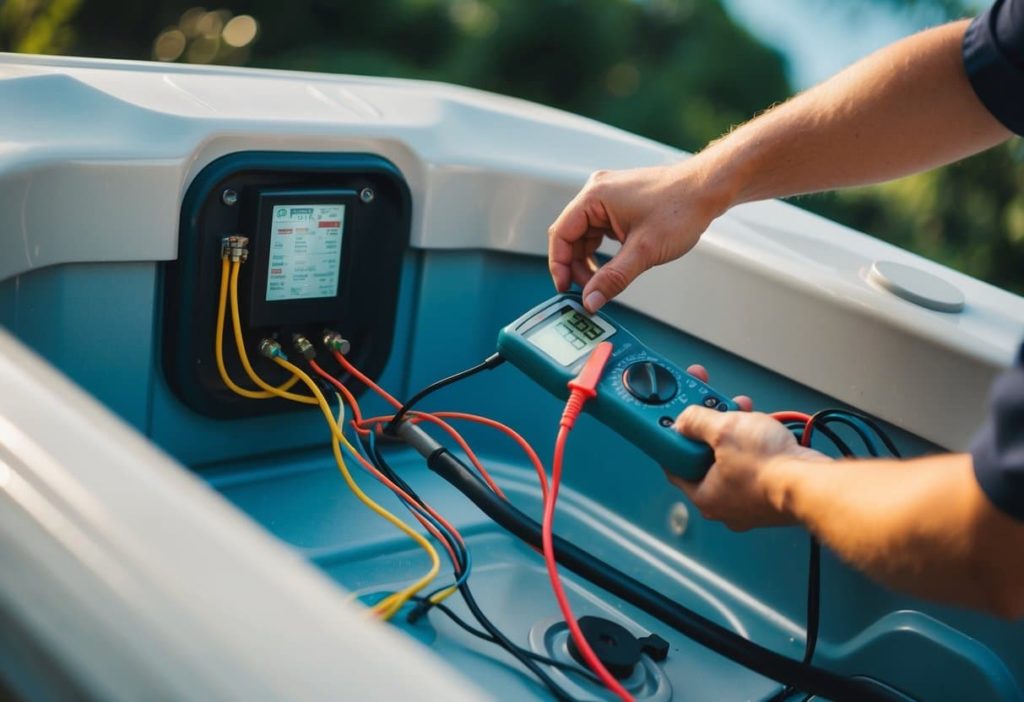
Keeping your hot tub in top shape requires regular care and knowing how to fix common problems. These tasks help ensure safe operation and prevent costly repairs.
Regular Inspections and Maintenance Tips
Check your hot tub’s electrical connections monthly. Look for signs of wear or damage on wires and connections. Tighten any loose connections carefully.
Clean or replace filters as needed, usually every 3-4 weeks. This keeps water clean and reduces strain on the pump.
Test water chemistry weekly and adjust as needed. Proper pH and sanitizer levels protect both bathers and equipment.
Drain and clean the tub every 3-4 months. Scrub surfaces and refill with fresh water.
Inspect the cover for tears or damage. Replace if needed to maintain energy efficiency.
Identifying Common Issues and Fixes
If jets aren’t working, check for:
- Clogged filters
- Air locks in plumbing
- Faulty pump
For weak jets, try:
- Cleaning filters
- Checking for leaks
- Adjusting valves
No heat? Look at:
- Thermostat settings
- Heater element
- Circulation pump
Odd noises could mean:
- Debris in pump
- Worn bearings
- Loose parts
Always turn off the power before inspecting electrical parts. Call a pro for complex electrical repairs.
Enhancing Your Hot Tub Experience

A well-designed hot tub setup can take your relaxation to new heights. The right features and surroundings make all the difference in creating a perfect home spa retreat.
Innovative Features and Accessories
Modern hot tubs offer amazing options to boost your soaking experience. LED lighting systems add a fun ambiance, with colour-changing modes to suit your mood. Built-in speakers let you enjoy your favourite tunes while you unwind.
Powerful jets provide soothing hydrotherapy, targeting key muscle groups. Some models have adjustable jets so you can customize the pressure. Waterfall features create a peaceful backdrop of flowing water.
For convenience, look for models with touchscreen controls. These make it easy to adjust temperature, jets, and other settings. Wi-Fi connectivity lets you warm up the tub before you get home.
Creating an Inviting Hot Tub Environment
The area around your hot tub is just as important as the tub itself. Start with a sturdy, non-slip surface like textured concrete or decking. This gives safe footing when entering and exiting.
Add privacy with fencing, lattice, or tall plants. This creates a secluded feel, even in a busy neighbourhood. Strategically placed lighting sets the mood without being too bright.
Comfy seating nearby gives a spot to relax before and after soaking. A small table holds drinks and snacks. For chilly nights, a patio heater keeps the surrounding area cozy.
Plant fragrant flowers or herbs to engage your senses. The scent of lavender or jasmine adds to the calming atmosphere. A pergola or gazebo provides shade and shelter from rain.
Frequently Asked Questions
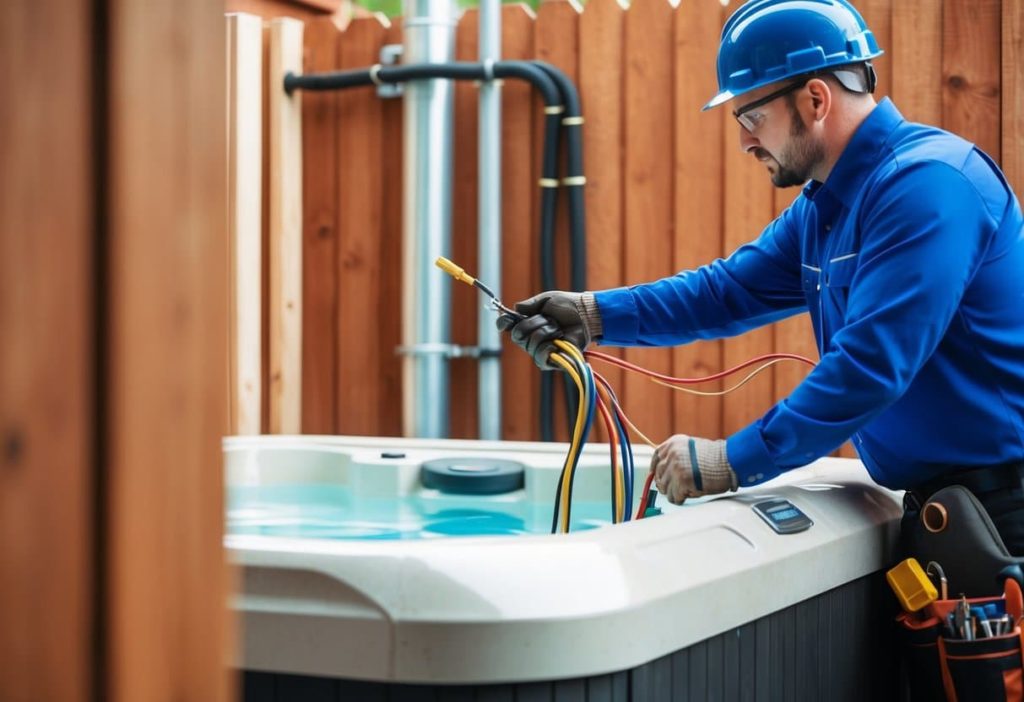
Hot tub wiring involves several key considerations. Proper materials, costs, codes, safety devices, and wire specifications are crucial for a safe and compliant installation.
What type of electrical conduit is required for a hot tub installation?
Rigid PVC conduit is often used for hot tub wiring. It’s durable and resistant to moisture. In some cases, metal conduit may be needed. Local codes may specify the required type.
How much does it typically cost to wire a hot tub?
The cost of wiring a hot tub ranges from $500 to $2,000. Factors affecting price include distance from the panel, labour rates, and materials needed. Complex installations may cost more.
Which electrical codes pertain to the installation of a hot tub?
The Canadian Electrical Code (CEC) governs hot tub wiring. Section 68 deals with pools, tubs, and spas. Local bylaws may add extra rules. It’s vital to check current codes before starting work.
Is a GFCI breaker necessary for hot tub wiring and if so, what amperage?
Yes, a GFCI breaker is required for hot tub wiring. The common amperage is 50 or 60 amps. The exact size depends on the hot tub’s power needs. Check the manufacturer’s specs for the right amperage.
What gauge of wire is recommended for connecting a hot tub?
For most hot tubs, 6 gauge copper wire is standard. Larger tubs may need 4 gauge wire. The wire size must match the breaker amperage and the tub’s power requirements.
Can I use aluminum wire for hooking up a hot tub, and what are the considerations?
Aluminum wire can be used but is not ideal for hot tubs. It’s cheaper but less conductive than copper. Aluminum needs larger gauge sizes and special connectors. It’s more prone to corrosion in damp areas.



